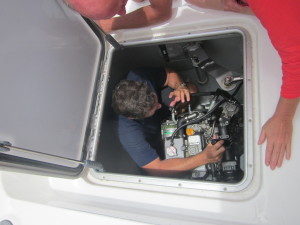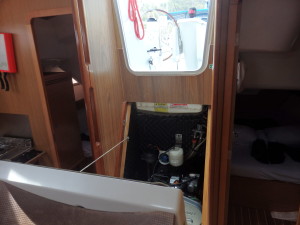Engine – CHECK! Caribbean Sailing School Check-list
What better place to earn ASA (American Sailing Association) certifications than with LTD Sailing’s Caribbean sailing school! LTD Sailing – “Living the Dream!” offers live-aboard courses in a tropical paradise! We sail in the Grenadines between St. Vincent and Grenada, West Indies! During our ASA 104 Coastal Cruising Course, you will learn about the systems on a cruising yacht. One of the important systems we cover during our Caribbean sailing school courses is the auxiliary power – engines.
To keep your engines running well and avoid problems, it’s important to perform a daily engine check.

Get to know the engine on a boat BEFORE it becomes a problem. The first thing you need to do is Locate the engine. Sounds easy, right? Usually, it will be under the stairs, under a bunk or it may have it’s own engine compartment. Do an overall visual check – are there any fluids spilled or leaking, any evidence of fraying belts or loose screws, etc.?
What you need: 1. Paper towel 2. Flashlight
During your daily engine check, there are five critical items to look at:
1. Check the belt:
It should have a little bit of play – a bit less than an inch. Look for cracks or any sign of the belt shredding, is the belt area covered in black dust? Is it too tight? Is there a proper replacement on board?

2. Inspect the raw water strainer:
Look for debris in the strainer. Is it clogged with leaves, seaweed, etc?
The procedure for cleaning the strainer is easy:
- Close the through hull valve. This stops water from flooding out if the stainer is below the water line or air from entering the system if the stainer is above the waterline.
- Unscrew the clear plastic cap from the strainer. This should ONLY be done hand tight and should not require any tools to unscrew.
- Lift the plastic strainer out and rinse clean.
- Replace strainer. HINT: It will only fit in one way. Ensure rubber gasket is in place and hand tighten lid. It should be snug but not over tight.
- WARNING! BE SURE TO REOPEN THE THROUGH HULL VAVLE! If the valve is left closed the engine will overheat.

3. Check the oil:
Just like checking the oil in your car, locate the dipstick and wipe clean. It should not be over-filled or filled. Some engine oils run dirtier than others so don’t be too alarmed by the color if you’re used to the usual golden hue from your car engine. Is there an extra quart on board? If at first, you get a low reading, always check again. The pressure in the crank case can cause a false reading.

4. Coolant level:
Look for the water line. Use your flashlight to shine from the back if you can’t see it clearly. Is there coolant? Is it the right level? It should be between the lines: Full :& Low.

5. Primary fuel filter/water separator:
The container should be a clear, golden color. If there is water, you will notice a distinct separation with the water in the bottom of the bowl. There is a valve at the bottom to allow draining out the water. Notice the sludge at the bottom of this fuel/water separator? Certain types of algae can grow in diesel fuel. This sludge can clog up the fuel filter and cause the engine to stop running. Be sure to use a Biocide fuel additive to prevent algae growth.

Taking the time to check your engine BEFORE you pull up anchor or leave the dock will save you heartache later. As the skipper, you are responsible for the boat. Get familiar with the engine. A brief overview of the engine should be included in your charter boat check-out. If not, ask.
SUGGESTION: Be aware that working with the engine, you might get a little dirty. Don’t wear anything that you don’t want to get greasy. In fact, in warmer climates, just wear your bathing suit and jump in the water after your engine check!
DO THIS FIRST:
ENGINE CHECK
- Belts
- Raw water strainer
- Fuel/water separator
- Coolant Level
- Oil level
So you can continue to do THIS:
![sunsail-44i-5[1]](https://www.ltdsailing.com/wp-content/uploads/2014/02/sunsail-44i-51-200x300.jpg)
Need more information? Reference: ASA Cruising Fundamentals by Harry Mums pg. 32 & 33
Make a copy of this blog and keep it in your sail bag, Even if you are confident in your engine checking skills, this will still be helpful for your crew. Even if they don’t actively participate in the maintenance of the boat, they can at least be familiar with the parts of an engine system.

